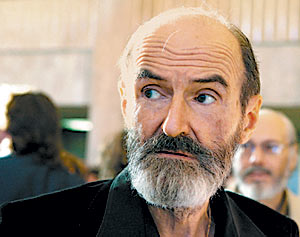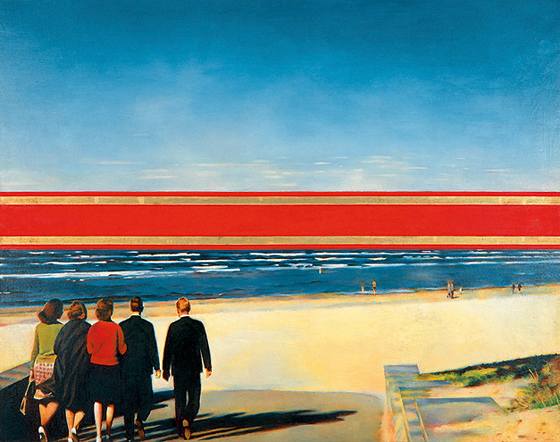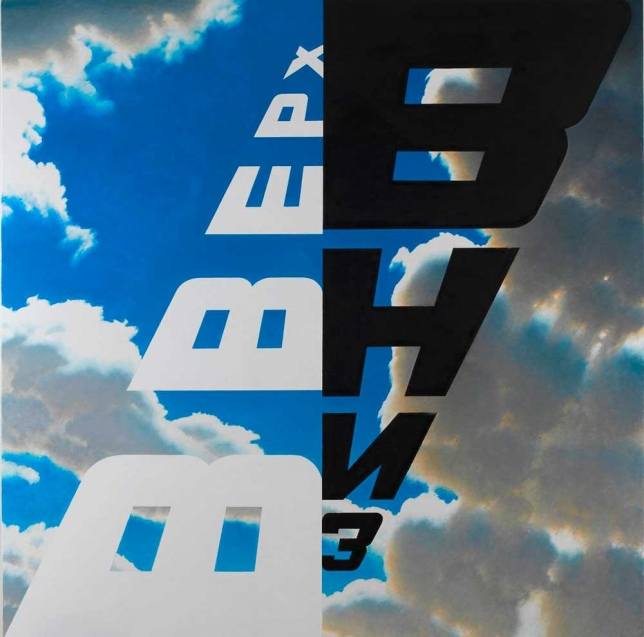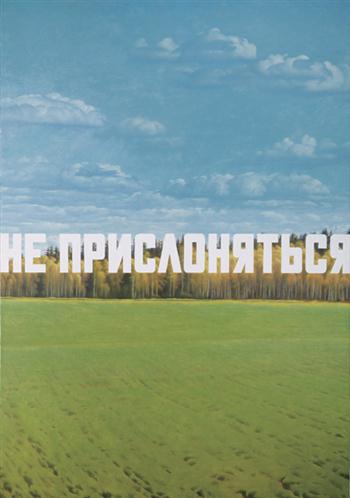Artist of the week: Eric Bulatov
To talk about the classics conceptualism excuse not needed. Still time to recommend to March 3 at the exhibition "Formal relations" - the dialogue of contemporary artist Vladimir Logutova and outstanding artists of the sixties Erik Bulatov

Erik Bulatov
Source: fairyroom.ru
«I was good at drawing, like many kids my age, so it was not surprising. But for some reason, my father was determined that I would be an artist ... Then the father went to the front and never returned. So for me and for my mother, it was as if his will. So I always knew I was an artist, even the question, what to become, for me, there was no ».
Erik Bulatov was born in Sverdlovsk, September 5, 1933. He grew up in Moscow. In 1947-1952 he studied at the Moscow Art School, during which time his favorite artists, according to the memoirs were and .
In 1952 Bulatov entered the Moscow State Academic Art Institute named after VI Surikov, who graduated in 1958. Years later he recalled his teachers: «Professor of Theatre faculty Mikhail Kurilko was definitely a bright personality. And my professor Peter D. Pokarzhevskogo I I recall with gratitude. But my most heartfelt gratitude to Mikhail Vladimirovich Alpatov. He chaired the Department of Art History, and never, even in the most brutal time, he did not say anything, then what he would be ashamed ».
While studying Bulatov much ruled out dialogue with prominent members of the "quiet art» - Falk and Favorsky , which are now considered to be the forerunners of nonconformists.
« By Falk I get caught even in the first year at the school, and at first did not understand anything, although interest arose immediately. Then I began to come to him when he was showing the work, watched, listened, and gradually began to understand and see things differently than before. And to Tabor we Oleg Vasiliev went without any advice, just like that. Found the address and went to ... it was an amazing person. He seems to be taught nothing, he just patiently answered our questions and never said more than he was asked. And when we understand and learn the answer, came with the following question, followed by a new response. And we are well aware that, no matter how deep we dig no, the answer will always be. He taught us to think, as they say, to the right brain. And outlined the problems that for both of us have become fundamental for life ».
After graduation, along with studies in Falk and Tabor, the company Vasilyev, Mikhail Mezhaninova and Ilya Kabakov Bulatov has traveled the cities of central Russia and the republics of the USSR. « Supervised these expeditions, the responsibility for all of us assumed the Bulatov, - recalled I. Kabakov . - He peksya about all of us, choosing those paths and routes that are convenient for all of his "staff" ».
In 1959, on the advice of Bulatov, Kabakov began studying child illustration (which eventually gave three decades), he worked for Detgiz and publishing "The Kid", usually painted in collaboration with Oleg Vasiliev. Together they participated in numerous Union exhibitions like "Artists - Children" and even won some awards there.
At the same time engaged in Bulatov and develop their own visual concepts (later it will be called one of the founders School of Moscow conceptualism). In the early, early 1960s, the works he developed the principles of cooperation, on the one hand, the surface and the interior of the picture, the other - the picture and the space around it.
In the early 1970s, the work of "Horizon" (1971/1972) brought the first known Bulatov, and with it the charges enthusiasm for social realism, from which the artist is still vehemently denies. It finally formed bulatovsky characteristic style, which combines hyperrealism (today some experts call it even photorealism) with elements of poster graphics and text views, "quotations" from the Soviet genre paintings exist in it next to the sans-serif Soviet posters and slogans, taken with banners. This confusion is unlikely it would be interesting if it were not born and most indispensable component bulatovskih interesting things - an optical illusion: the graphics and font line drawings Bulatov creates extra space and uses it as a painting techniques, that is, not only works line, color and light but space or lack of it.
However, calling Bulatov (and Vasiliev, of course) «a kind of aesthetic monsters against the prevailing informal aesthetics of the time," Ilya Kabakov accused him of refusing to «from the development of individual style, authentic artistic language» and work «with ready Soviet style» . However, it should be noted that this ready-Soviet style Bulatov gives new meaning. He did not divorce paintings and graphic elements, and has a number, but as if in different dimensions. Thus, Bulatov in the works of the Soviet period shows that in the same place at the same time, there is a part of the plane, rigidly organized words, slogans and poster graphics, and three-dimensional space in which the fugitive growing birches and swim in the blue sky unorganized clouds. Interestingly, the Bulatov, not "letting go" of the graph of a plane in three-dimensional, shows the line between propaganda and reality, politics and art, art space and the space of the viewer (the text that the viewer reads and who reminds him of his images that complement your own eye number of paintings as a bridge between the theoretical space of the picture space and induced her audience imagination).
 Bulatov Horizon. 1971/1972 canvas. 150 x 180 Source: afisha.ru | Bulatov Glory to the CPSU. 1975 canvas. 2295 x 2290 Phillips de Pury. 28.02.2008 Estimate: 500 000-700 000 pounds Result: 1,084,500 pounds Source: |
fair to say that the interest was not limited to Bulatov conceptual works with a complex structure. He wrote and portraits (usually friends) and landscapes (mostly sketches).
In the late 1970's - 1980's in the works Bulatov increased political component to the neutral landscapes Add images and images of leaders and current at the time of political motivation: Brezhnev, Gorbachev, Restructuring , unanimously .
exhibited Bulatov began in his student years, first in the exhibitions of young artists, then - illustrators, and still later, in 1965, was screened in the cultural IAE. Kurchatov, in 1968, together with Kabakov and Vasiliev he exhibited at the Cafe "Blue Bird", from the 1970s his work appeared in the international group exhibitions, and in 1988 in Zurich, took the first solo foreign exhibition.
In 1989 Bulatov went to New York, and two years later settled in Paris. It is significant that his life in Paris began with a solo exhibition at the Centre Georges Pompidou (a significant event for any French artist and almost unbelievable emigre artists, by the way, Bulatov - the first Russian artist, awarded this honor).
From the mid-1990s, his work became less politics, but most of the game - with the text, its meaning and position in space. Bulatov entrain image problems on the plane of abstract concepts such as "top", "bottom", "there", "here" or "here." Devoid of political color, they bulatovskih paintings are much more freedom than their predecessors.
In the past few years, the artist refers to ceramics: Bulatov again experimenting with space, but this time not imaginary three-dimensional, in the plane of the picture, and the present, limited object (plate).
 Bulatov up and down. 2011 canvas. 200 x 200 Source:  Bulatov Sky - ciel. 2010 plate, porcelain Source: |
Thin, crisp, with clean lines and a great sense of fullness Bulatov require careful preparation and a long reflection and painstaking execution flawless. "... If I finish one job and if it is obtained, - says Bulatov , - something is revealed to me and I can do next. That is, they go to a chain, one follows from the other. And if not, then a bad deal. But sooner or later anyway, this chain is restored ... I have published three or four films a year, no longer have time to ... In commercial terms, this is an exceptional situation, simply unique. But I still have this opportunity ».
fact, rare in our time. Despite such low rates of Bulatov - very successful commercially artist. His work is sold mainly to significant excess of the estimate. For example, one of the most expensive of his work - "not lean" in summer 2007, while the estimate of 100-150 thousand pounds was sold to more than 900,000.
 Bulatov Do not lean. 1987 canvas. 240 x 169 Phillips de Pury. 22.06.2007 Estimate: 100 000-150 000 pounds Result: 916,000 pounds Source: |
Bulatov works included in the collections of major museums around the world such as the Center for Contemporary Art. Georges Pompidou in Paris, the Museum Ludwig in Cologne, the Museum of Art Basel, the Zimmerli Museum (New Jersey, USA). In Russia, it is represented in the collections of the State Tretyakov Gallery and the Russian Museum, the Cultural Foundation "Ekaterina" and the Museum of Contemporary Art art4.ru
Maria Kuznetsova, AI
Sources : arndtberlin.com ; fairyroom.ru ; afisha.ru ; conceptualism-moscow.org ;« Other Art ": Moscow 1956-1988. Moscow, 2005; artinvestment.ru
Permanent link to:
https://artinvestment.ru/en/invest/artistofweek/20130228_bulatov.html
https://artinvestment.ru/invest/artistofweek/20130228_bulatov.html
© artinvestment.ru, 2024
Attention! All materials of the site and database of auction results ARTinvestment.RU, including illustrated reference information about the works sold at auctions, are intended for use exclusively for informational, scientific, educational and cultural purposes in accordance with Art. 1274 of the Civil Code. Use for commercial purposes or in violation of the rules established by the Civil Code of the Russian Federation is not allowed. ARTinvestment.RU is not responsible for the content of materials submitted by third parties. In case of violation of the rights of third parties, the site administration reserves the right to remove them from the site and from the database on the basis of an application from an authorized body.


